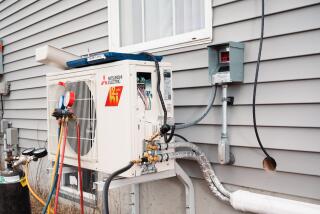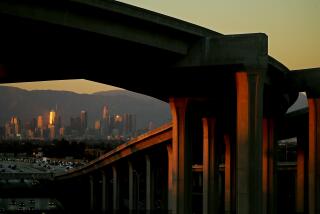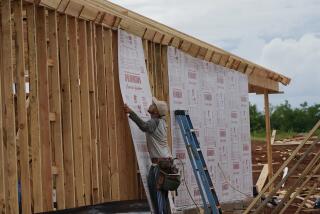Green builders find that location matters
- Share via
Reporting from Chicago — If you plop a green building in the middle of nowhere, is it still green?
That’s exactly what businesses, sustainability experts and planners are trying to find out. The growing “green buildings” movement is taking a new direction with the development of computer models that go beyond measuring a building’s carbon footprint and attempt to quantify the amount of energy people consume to reach that building.
Take electric utility Exelon Corp.’s uber-green headquarters in downtown Chicago, with its energy-efficient lighting, intelligent heating, ventilation and cooling systems that power down on command, and lights that shut off automatically when a room is unoccupied. If we could airlift that building to the Illinois suburb of Hoffman Estates, how green would it be?
A calculator developed recently by the Chicago-based Center for Neighborhood Technology shows that with Exelon in the downtown district, 55% of its employees take public transportation to work and a small percentage bike or walk. But in Hoffman Estates, where public transportation is scarce, 99% of those employees would drive to work, with only 10% carpooling.
The energy spent commuting to Hoffman Estates, measured in British thermal units, would double. And each employee would add 22.9 pounds of heat-trapping gases to the atmosphere per day just getting to and from work there as opposed to 16.2 pounds to the Chicago site. (As a point of reference, cars emit about 25 pounds of carbon dioxide for every gallon of gas.)
Experts say the ability to quantify the energy spent getting to and from a building could force businesses to reconsider what it means to be green. Transportation emissions account for 29% of total U.S. greenhouse gas emissions, according to the Environmental Protection Agency, and the newly quantifiable data could spur development in urban areas served by public transportation.
Commutes to work matter, said Emma Stewart, senior manager for sustainability at Autodesk Inc., a San Rafael, Calif., maker of 3-D design software applications. Overall, one out of five trips and one out of four miles are traveled in commutes, according to Census Transportation Planning Products. For work, people fly to conferences, hail cabs on lunch breaks and drive to far-flung suburbs.
“This is a new frontier in carbon accounting,” said Stewart, who is part of a separate effort to digitally map buildings and infrastructure like train lines for urban planning purposes. “The practice thus far has really been focused around direct emissions.”
Indirect emissions such as travel emissions are harder to control, she said, but once quantified can be managed.
Autodesk is encouraging employees to teleconference to meetings, Stewart said, and has added the equipment to make that possible after measuring the kilowatt hours the company invested in transporting employees to events, conferences, expos and internal meetings.
“We now have 18 telepresence sites, 50 roundtable systems, and every employee has the right to a webcam,” she said.
Opponents to the new green order are companies that have traditionally built in more remote areas because land is cheaper, said Martha VanGeem, head of Chicago-based CTLGroup’s building science and sustainability practice.
VanGeem helped draft and develop the ASHRAE Standard 189.1, which is a system from the American Society of Heating, Refrigerating and Air-Conditioning Engineers that is similar to Leadership in Energy and Environmental Design, or LEED, but in a format for building codes.
To be green, the ASHRAE standard requires that buildings be located in developed areas or within walking distance of at least 10 services (grocery stores, restaurants, banks, etc.), a train or subway station, a bus stop or apartments or condominiums.
Adding that standard was a fight, VanGeem said, particularly among large manufacturing companies.
“We’re trying to reduce a building’s footprint, but what we found is that commuters are having a bigger footprint than the buildings themselves a lot of times,” she said. “So we have to focus on the commuters.”
More than 60% of businesses leasing commercial office space (and the people who work for them) say a building’s proximity to transportation is an important factor in their decision to lease space and for quality of life, according to a survey of managers and building occupants by McGraw-Hill Construction.
“It’s kind of implicit in some things, right?” said Peter Hass, chief research scientist at the Center for Neighborhood Technology in Chicago. “When you get an apartment and it says, ‘near the L,’ for instance,” he said, referring to Chicago’s elevated railway, “they could charge more for rent. There’s implicit value there.”
But thus far, quantifying how location affects carbon footprints has been a challenge.
Since its launch in 2000, LEED, the bible of green certification systems, has focused mostly on the building, not where it is located. The system gives points for locating a building near public transportation and other services, but organizations such as the Sustainable Sites Initiative have argued that the standards lack comprehensive criteria.
In 2008, the American Physical Society found that “the lack of an agreed-upon method for quantifying these issues” was a significant obstacle for policymakers.
“Different studies frame the questions in different ways, and different sources provide different predictions that are qualitatively in agreement but yield slightly different, or mutually incomparable, predictions,” the group wrote.
But greater interest in the energy expended in commuting and other travel recently led the U.S. Green Building Council, the authors of LEED, to retool that focus. It has hired the Center for Neighborhood Technology to research a tool that can predict the energy required to travel to a building based on its location.
Using a complex formula that combines transportation and census data, the center developed a free online tool, launching early this year, that promises to deliver that kind of information in a matter of minutes.
Interest in the Transportation Energy Index from sustainability managers, transportation alliances, urban planners and even the federal government is intense because the tool could alter the green world order.
The center acknowledges that its tool is still far from perfect.
“You have to understand why the people get there, how far they have to go, what kind of transportation they use, what the energy impact is of that,” Haas said.
The tool uses “as the crow flies” miles, rather than mapped routes to determine the transportation efficiency of a building. It relies on census data and the National Transit Database to determine where visitors are generally traveling from and the modes of transportation they are likely to use or have available.
And it can get even more complicated. A grocery store, for instance, will have a different breakdown of visitors and trips than a law firm. Also, the more money a person earns, the farther they are likely to travel to work, Haas said, and the more energy they are likely to use. Some chief executives commute to work by jet.
The tool attempts to handle such elements with menus that allow the user to enter the primary use of a building and the average salary of its employees. To further tweak the mathematical model, users can also type in square footage, average daily visitors and the number of days per year the building is open.
Without that information, they rely on census averages and data from the U.S. Energy Information Administration’s Commercial Buildings Energy Consumption Survey, such as the average size of a typical office building, the average days a nursing facility is open or the average salary of someone who works in a school, for example.
It also doesn’t take into account regional differences, said Linda Young, research director for the Center for Neighborhood Technology. For instance, some cities have hybrid bus systems or all-electric train lines that expend far less energy than their diesel-spewing counterparts. Young said the center would like to develop a post-occupancy tool that allows users to survey and enter data based on the responses of employees.
“This is the first iteration of this calculator out there. We want people to be able to look at it, play with it, provide some feedback,” Young said.
The idea, she said, is to give businesses a measurement tool so that they can improve.
“Certain things can affect it: Encouraging biking, adding a kitchen so that employees don’t have to leave for lunch, offering transportation passes,” she said.
More to Read
Inside the business of entertainment
The Wide Shot brings you news, analysis and insights on everything from streaming wars to production — and what it all means for the future.
You may occasionally receive promotional content from the Los Angeles Times.










